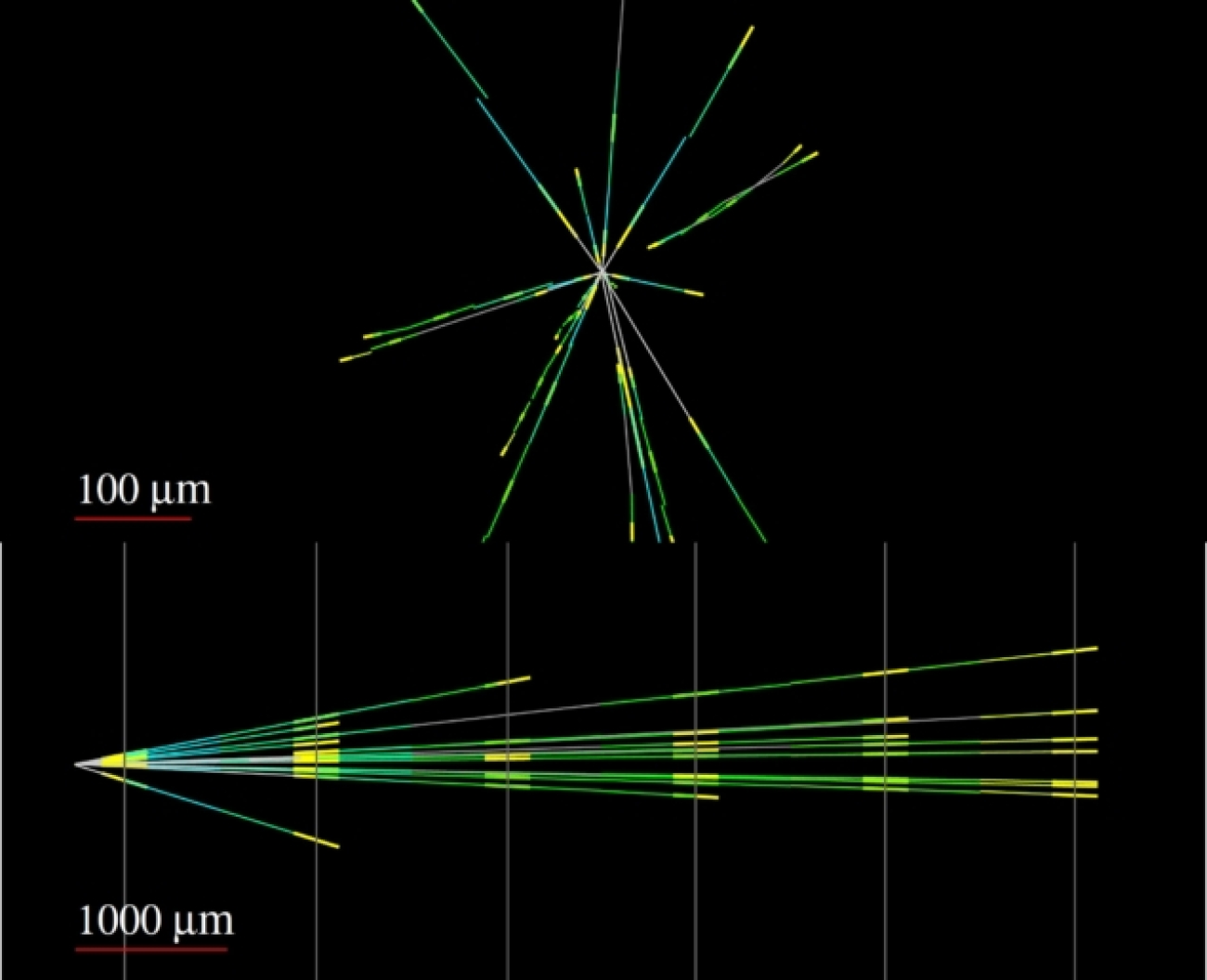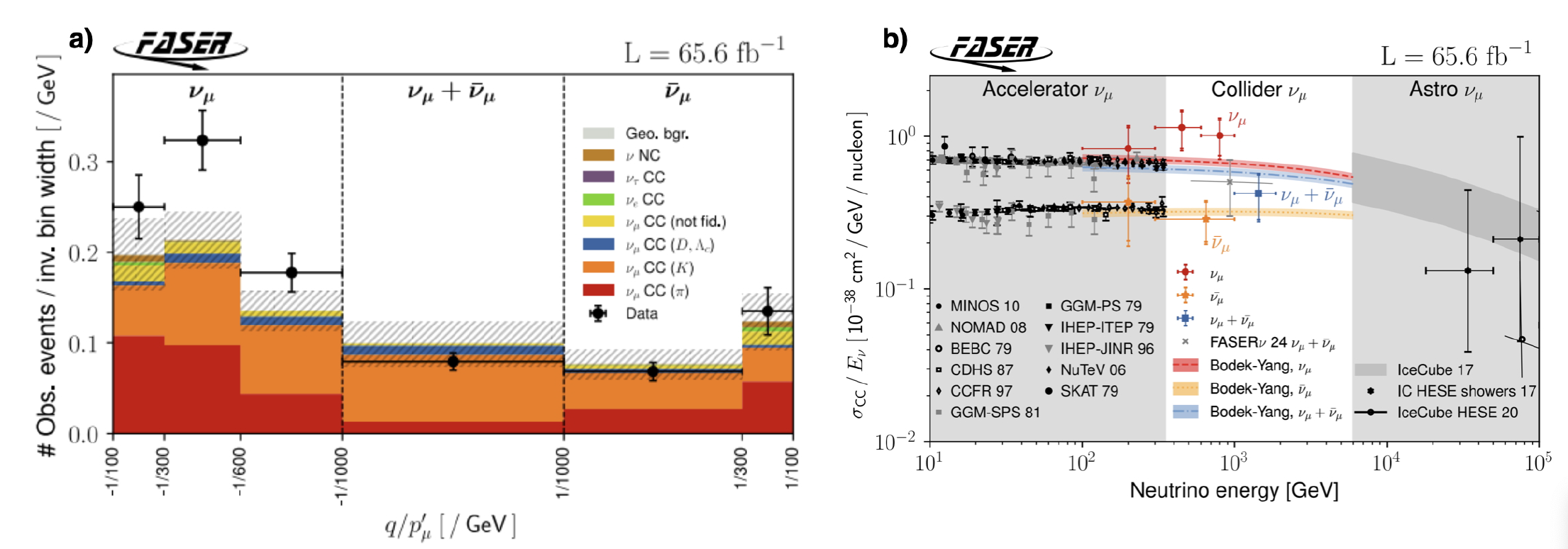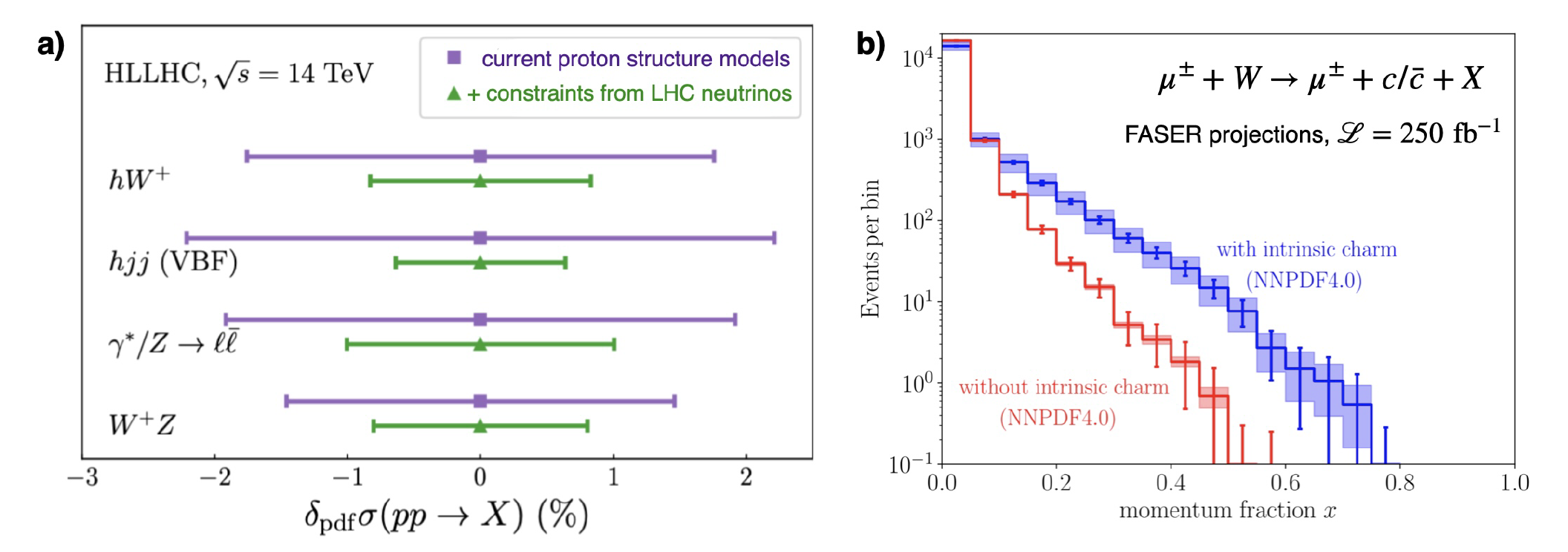Welcome to the Collider Neutrino Era!

Searches for new fundamental particles and interactions at hadron collider experiments such as the SPS, the TeVatron, and the LHC have traditionally focused on heavy and relatively strongly interacting states. The two general-purpose experiments of the LHC, ATLAS and CMS, were for this reason designed to cover the central acceptance region, perpendicular to the proton-proton beam collision axis, where heavy particles such as Higgs bosons, top quarks, or supersymmetric and dark matter particles would be detected. Instead, the forward region of LHC collisions, parallel to the beam axis, has received less attention due to the traditional assumption that limited interesting physics signals were to be found there, with the notable exception of B-mesons for flavour physics.
Nevertheless, it was acknowledged already in the 1980s [1] and then in subsequent studies [2,3,4,5,6,7] that high-energy proton collisions generate intense, high-energy, and strongly collimated beams of neutrinos and muons in the forward direction. At the LHC, these forward neutrinos generated in proton collisions are characterised by the highest energies ever achieved in a laboratory, reaching up to several TeVs [8,9,10]. Likewise, many compelling New Physics scenarios predict new light and feebly interacting particles (FIPs), for instance Dark Matter mediators. Similarly to neutrinos, such light particles could also be profusely produced in the forward region of LHC collisions, enabling new (and currently untapped) avenues for BSM exploration.
To unlock the unparalleled scientific potential of forward light particle production at the LHC, both for SM particles (neutrinos and muons) and for light BSM states, two dedicated far-forward experiments, FASER [11] and SND@LHC [12], were installed and started to acquire data in 2022. The two detectors are located about 480 m downstream at opposite sites of the ATLAS interaction point (IP), shielded by around 100 m of meters of rock and concrete. The groundbreaking observation in 2023 of neutrinos produced in LHC collisions by FASER [13] and SND@LHC [14, 15], followed by subsequent measurements of the neutrino flux and interaction cross-section at TeV energies by FASER [16,17,18], herald a “collider neutrino era” opening a new field within particle physics. Fig. 1 illustrates a possible production mechanism of forward electron neutrinos in proton collisions at ATLAS, through D-meson decay. These neutrinos can then be detected at FASER and SND@LHC via their inelastic scattering off the nucleons in the target, with an energetic charged lepton (here an electron) as the tell-tale final-state signature.

Figure 1. Proton-proton collisions at the ATLAS experiment of the LHC (left) produce an intense flux of light particles, including neutrinos and muons, in the forward direction parallel to the proton beams. One possible mechanism of electron neutrino production is through the decays of charmed D-mesons. LHC neutrinos and muons can then be detected at the far-forward detectors FASER (right) and SND@LHC via inelastic scattering off the nucleons in the target.
Representative results of the LHC neutrino program are shown in Fig. 2. The left panel displays the measurement of the number of muon (anti)neutrino interactions at FASER for ℒ = 65.6 fb−1 as a function of q/p′μ, with q and p′μ being the charge and the momentum of the final-state muon. Assuming SM scattering cross-sections, these measurements can be interpreted in terms of the LHC forward muon fluxes to constrain models of forward hadron production in high-energy collisions. The right panel of Fig. 2 then compares FASER measurements of the muon neutrino cross-sections with those from accelerators (at lower energies) and from neutrino telescopes (at higher energies), highlighting how the LHC neutrino experiments cover the gap at TeV energies between accelerator and astrophysical experiments.

Figure 2. (a) Measurement of the number of muon (anti)neutrino interactions at FASER for ℒ = 65.6 fb−1 as a function of q/p′μ, with q and p′μ being the charge and the momentum of the final-state muon. (e) FASER measurements of the muon neutrino cross-sections at TeV energies cover the gap between accelerator and astrophysical neutrinos.
Complementing this rich neutrino program, FASER also has a thriving portfolio of New Physics searches, including FIPs, long-lived particles (LLPs), dark matter mediators [19], quirks [20] and heavy neutral leptons [21], among many other scenarios [22, 23]. These searches have already resulted in world-leading bounds for axion-like particles [24] and dark photons [25]. New Physics sensitivity at FASER and SND@LHC also arises through eventual non-standard neutrino interactions (NSI) parametrized for instance by higher-dimensional Effective Field Theory (EFT) operators [26], and even by distinguishing between Dirac and Majorana neutrinos [27].
Thanks to recent proof-of-concept studies involving both theorists and experimentalists, it is now well-established that the neutrinos and muons reaching FASER and SND@LHC enable a unique portfolio of scientific studies in strong interaction, neutrino, and astroparticle physics, see [28, 29, 30, 31, 32, 34] and references therein. These include the determination of LHC forward neutrino fluxes to scrutinize forward light and heavy hadron production in QCD and scrutinising solutions for the muon puzzle hindering cosmic ray experiments [35, 36, 37]; the search for signatures of novel QCD dynamics such as saturation effects, accessing the gluon content of the proton beyond any other laboratory experiment, performing precise calculations for the prompt atmospheric flux from charm meson decays [38, 39, 40], representing main background at neutrino telescopes; and the first TeV-scale neutrino and muon deep-inelastic scattering structure function measurements, enabling improved theoretical predictions for Higgs boson [32] production and for New Physics searches at ATLAS and CMS [41, 42, 43], among many other exciting prospects.
To illustrate this potential, Fig. 3 (left) shows how the inclusion of LHC neutrino scattering data in global analyses of proton structure [32] will lead to improved theoretical predictions for Higgs and electroweak processes at the HL LHC thanks to a reduction of the dominant PDF uncertainties. Then Fig. 3 (right) presents the projected event yields for charm production in muon DIS at FASER, which can constrain the charm content of the proton and disentangling a possible intrinsic (non-perturbative) component [44]. Its existence has been hotly debated in the QCD community for decades.

Figure 3. a) The inclusion of LHC neutrino data on global fits of proton structure [32] is projected to lead to precise theoretical calculations for Higgs and electroweak processes at the HL-LHC. b) Charm production in muon DIS at FASER will disentangle the charm content of the proton, resolving a possible intrinsic (non-perturbative) component [44].
Both FASER and SND@LHC will take data until the end of Run 3 of the LHC in the summer 2026. Upgrades for both experiments are approved for operation in Run 4, starting in 2030, in the High-Luminosity LHC (HL-LHC) era with similarly sized detectors at the same locations [45, 46]. For instance, FASER is expected to accumulate around 7 x 103, 4 x 104 and 120 electron, muon, and tau neutrino events [10] adding up both the Run 3 and Run 4 (680 fb−1) data samples. Recall that, to date, only a handful of tau neutrinos have been detected worldwide. In addition to these confirmed HL-LHC upgrades of FASER and SND@LHC, a significant expansion of the collider neutrino program with significantly larger detectors has been proposed in the context of the Forward Physics Facility (FPF) [47], for which a Letter of Intent is being finalised.
Crucially, we should emphasize how timely these collider neutrino experiments are: after all, the availability of collider neutrinos is intrinsically linked to LHC operations. Therefore, exploiting their full potential during the (HL-)LHC operation is essential, with no other alternative experiment with similar reach, such as the FCC-hh [48] becoming operative in decades. Furthermore, the LHC neutrino experiments support a fully sustainable experimental program, with marginal energy requirements beyond the needs of the existing LHC program by “recycling” for science neutrino and muon beams which would otherwise be discarded.
All in all, the prospects of this new collider neutrino era appear remarkably promising. We are given a unique chance to unlock the strong interactions, neutrino physics, and extreme astroparticle processes with collider neutrinos, and it is our responsbility to do our best to fully exploit it.
References
- A. De Rujula, NEUTRINO PHYSICS AT FUTURE COLLIDERS, 1984.
- K. Winter, Detection of the tau-neutrino at the LHC, in ECFA Large Hadron Collider (LHC) Workshop: Physics and Instrumentation, pp. 37–49, 1990.
- A. De Rujula, E. Fernandez and J. J. Gomez-Cadenas, Neutrino fluxes at future hadron colliders, Nucl. Phys. B 405 (1993) 80–108.
- F. Vannucci, Neutrino physics at LHC / SSC, in 4th International Symposium on Neutrino Telescopes, 3, 1993.
- H. Park, The estimation of neutrino fluxes produced by proton-proton collisions at √s = 14 TeV of the LHC, JHEP 10 (2011) 092, [1110.1971].
- N. Beni et al., Physics Potential of an Experiment using LHC Neutrinos, J. Phys. G 46 (2019) 115008, [1903.06564].
- P. Foldenauer, F. Kling and P. Reimitz, Potential of CMS as a high-energy neutrino scattering experiment, Phys. Rev. D 104 (2021) 113005, [2108.05370].
- F. Kling and L. J. Nevay, Forward neutrino fluxes at the LHC, Phys. Rev. D 104 (2021) 113008, [2105.08270].
- L. Buonocore, F. Kling, L. Rottoli and J. Sominka, Predictions for neutrinos and new physics from forward heavy hadron production at the LHC, Eur. Phys. J. C 84 (2024) 363, [2309.12793].
- FASER collaboration, R. Mammen Abraham et al., Neutrino rate predictions for FASER, Phys. Rev. D 110 (2024) 012009, [2402.13318].
- FASER collaboration, H. Abreu et al., The FASER detector, JINST 19 (2024) P05066, [2207.11427].
- SND@LHC collaboration, G. Acampora et al., SND@LHC: the scattering and neutrino detector at the LHC, JINST 19 (2024) P05067, [2210.02784].
- FASER collaboration, H. Abreu et al., First Direct Observation of Collider Neutrinos with FASER at the LHC, Phys. Rev. Lett. 131 (2023) 031801, [2303.14185].
- SND@LHC collaboration, R. Albanese et al., Observation of Collider Muon Neutrinos with the SND@LHC Experiment, Phys. Rev. Lett. 131 (2023) 031802, [2305.09383].
- SND@LHC collaboration, D. Abbaneo et al., Observation of Collider Neutrinos without Final State Muons with the SND@LHC Experiment, Phys. Rev. Lett. 134 (2025) 231802, [2411.18787].
- FASER collaboration, R. Mammen Abraham et al., First Measurement of νe and νµ Interaction Cross Sections at the LHC with FASER’s Emulsion Detector, Phys. Rev. Lett. 133 (2024) 021802, [2403.12520].
- FASER collaboration, R. Mammen Abraham et al., First Measurement of the Muon Neutrino Interaction Cross Section and Flux as a Function of Energy at the LHC with FASER, Phys. Rev. Lett. 134 (2025) 211801, [2412.03186].
- CERN-LHC-FASER collaboration, F. U. Bernlochner, W. Filali, T. Bockh, M. Queitsch-Maitland and F. Kling, Measurement of the Muon Neutrino Flux as a Function of the Rapidity with FASER, in 59th Rencontres de Moriond on Electroweak Interactions and Unified Theories.
- C.-T. Lu, J. Tu and L. Wu, Probing inelastic dark matter at the LHC, FASER, and STCF, Phys. Rev. D 109 (2024) 015018, [2309.00271].
- J. L. Feng, J. Li, X. Liao, J. Ni and J. Pei, Discovering quirks through timing at FASER and future forward experiments at the LHC, JHEP 06 (2024) 197, [2404.13814].
- F. Kling and S. Trojanowski, Heavy Neutral Leptons at FASER, Phys. Rev. D 97 (2018) 095016, [1801.08947].
- F. Kling, S. Li, H. Song, S. Su and W. Su, Light Scalars at FASER, JHEP 08 (2023) 001, [2212.06186].
- H. K. Dreiner, D. Ko¨hler, S. Nangia and Z. S. Wang, Searching for a single photon from lightest neutralino decays in R-parity-violating supersymmetry at FASER, JHEP 02 (2023) 120, [2207.05100].
- FASER collaboration, R. Mammen Abraham et al., Shining light on the dark sector: search for axion-like particles and other new physics in photonic final states with FASER, JHEP 01 (2025) 199, [2410.10363].
- FASER collaboration, H. Abreu et al., Search for dark photons with the FASER detector at the LHC, Phys. Lett. B 848 (2024) 138378, [2308.05587].
- A. Falkowski, M. Gonza´lez-Alonso, J. Kopp, Y. Soreq and Z. Tabrizi, EFT at FASERν, JHEP 10 (2021) 086, [2105.12136].
- S. K. A., A. Datta and D. Marfatia, Distinguishing between Dirac and Majorana neutrinos at FASER,2508.00170.
- L. A. Anchordoqui et al., The Forward Physics Facility: Sites, experiments, and physics potential, Phys. Rept. 968 (2022) 1–50, [2109.10905].
- A. Ariga, J. Boyd, F. Kling and A. De Roeck, Neutrino Experiments at the Large Hadron Collider,2501.10078.
- F. Kling, Neutrino Physics at the LHC: Status and Prospects, in 29th International Symposium on Particles, String and Cosmology, 1, 2025. 2501.07152.
- J. Adhikary et al., Scientific program for the Forward Physics Facility, Eur. Phys. J. C 85 (2025) 430, [2411.04175].
- J. M. Cruz-Martinez, M. Fieg, T. Giani, P. Krack, T. Ma¨kela¨, T. R. Rabemananjara et al., The LHC as a Neutrino-Ion Collider, Eur. Phys. J. C 84 (2024) 369, [2309.09581].
- J. John, F. Kling, J. Koorn, P. Krack and J. Rojo, A First Determination of the LHC Neutrino Fluxes from FASER Data, 2507.06022.
- J. Rojo, Deep-inelastic scattering with collider neutrinos at the LHC and beyond, PoS DIS2024 (2025) 037, [2407.06731].
- J. Albrecht et al., The Muon Puzzle in cosmic-ray induced air showers and its connection to the Large Hadron Collider, Astrophys. Space Sci. 367 (2022) 27, [2105.06148].
- L. A. Anchordoqui, C. G. Canal, F. Kling, S. J. Sciutto and J. F. Soriano, An explanation of the muon puzzle of ultrahigh-energy cosmic rays and the role of the Forward Physics Facility for model improvement, JHEAp 34 (2022) 19–32, [2202.03095].
- S. J. Sciutto, L. A. Anchordoqui, C. Garcia Canal, F. Kling and J. F. Soriano, Gauging the cosmic ray muon puzzle with the Forward Physics Facility, PoS ICRC2023 (2023) 388, [2307.08634].
- R. Laha and S. J. Brodsky, IceCube can constrain the intrinsic charm of the proton, Phys. Rev. D 96 (2017) 123002, [1607.08240].
- R. Gauld, J. Rojo, L. Rottoli and J. Talbert, Charm production in the forward region: constraints on the small-x gluon and backgrounds for neutrino astronomy, JHEP 11 (2015) 009, [1506.08025].
- PROSA collaboration, M. V. Garzelli, S. Moch, O. Zenaiev, A. Cooper-Sarkar, A. Geiser, K. Lipka et al., Prompt neutrino fluxes in the atmosphere with PROSA parton distribution functions, JHEP 05 (2017) 004, [1611.03815].
- E. Hammou, Z. Kassabov, M. Madigan, M. L. Mangano, L. Mantani, J. Moore et al., Hide and seek: how PDFs can conceal new physics, JHEP 11 (2023) 090, [2307.10370].
- E. Hammou and M. Ubiali, Unravelling new physics signals at the HL-LHC with EIC and FPF constraints, Phys. Rev. D 111 (2025) 095028, [2410.00963].
- A. Greljo, S. Iranipour, Z. Kassabov, M. Madigan, J. Moore, J. Rojo et al., Parton distributions in the SMEFT from high-energy Drell-Yan tails, JHEP 07 (2021) 122, [2104.02723].
- R. Francener, V. P. Goncalves, F. Kling, P. Krack and J. Rojo, Deep-Inelastic Scattering at TeV Energies with LHC Muons, 2506.13889.
- FASER collaboration, R. Mammen Abraham et al., Prospects and Opportunities with an upgraded FASER Neutrino Detector during the HL-LHC era: Input to the EPPSU, 2503.19775.
- SND@LHC collaboration, D. Abbaneo and all, SND@HL-LHC, Scattering and Neutrino Detector in Run 4 of the LHC, tech. rep., CERN, Geneva, 2025.
- J. L. Feng et al., The Forward Physics Facility at the High-Luminosity LHC, J. Phys. G 50 (2023) 030501, [2203.05090].
- R. Mammen Abraham, J. Adhikary, J. L. Feng, M. Fieg, F. Kling, J. Li et al., FPF@FCC: neutrino, QCD, and BSM physics opportunities with far-forward experiments at a 100 TeV Proton Collider, JHEP 01 (2025) 094, [2409.02163].
